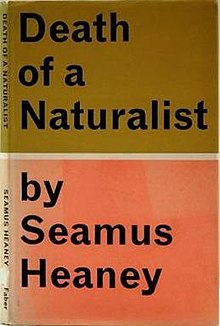Death of a Naturalist

First Edition
|
|
| Author | Seamus Heaney |
|---|---|
| Language | English |
| Publisher | Faber and Faber |
|
Publication date
|
1966 |
| Media type | |
| Pages | 58 pp |
| ISBN | |
| OCLC | 4686783 |
| Followed by | Door into the Dark |
Death of a Naturalist (1966) is a collection of poems written by Seamus Heaney, who received the 1995 Nobel Prize in Literature. The collection was Heaney's first major published volume, and includes ideas that he had presented at meetings of The Belfast Group. Death of a Naturalist won the Cholmondeley Award, the Gregory Award, the Somerset Maugham Award, and the Geoffrey Faber Memorial Prize.
The work consists of 34 short poems and is largely concerned with childhood experiences and the formulation of adult identities, family relationships, and rural life. The collection begins with one of Heaney's best-known poems, "Digging", and includes the acclaimed "Death of a Naturalist" and "Mid-Term Break".
From Mid-term Break
Wearing a poppy bruise on his left temple,
He lay in the four foot box as in his cot.
No gaudy scars, the bumper knocked him clear.
"Death of a Naturalist," the collection's second poem, details the exploits of a young boy collecting frogspawn from a flax-dam. The narrator remembers everything he saw and felt at those times. He then remembers his teacher telling him all about frogs in a section that speaks volumes about childhood innocence. Finally, we hear about a trip to the flax-dam that went wrong. He feels threatened by the frogs and flees. His interest in nature has gone – this is the death of a "naturalist" suggested in the poem's title. The poem makes extensive use of onomatopoeia and a simile that compares the behaviour of the amphibians to warfare ("Some sat poised like mud grenades") amongst other techniques.
"Mid-Term Break" is a reflection on the death of Heaney's four-year-old brother, Christopher, while Heaney was at school. He describes his parents' different ways of displaying grief, visitors paying their respects, and his encounter of his brother's corpse in its coffin the next morning. The poem focuses on concrete particulars of Heaney's experience and "captures a boy’s unfolding consciousness of death." The final line ("A four foot box, a foot for every year.") emphasizes death's finality.
...
Wikipedia
